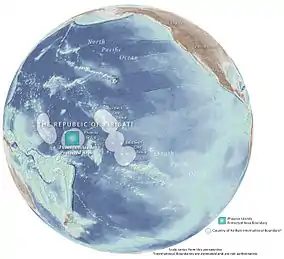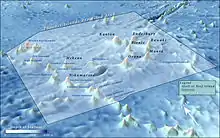Phoenix Islands Protected Area
The Phoenix Islands Protected Area (PIPA) is located in the Republic of Kiribati, an ocean nation in the central Pacific approximately midway between Australia and Hawaii. PIPA constitutes 11.34% of Kiribati's Exclusive Economic Zone (EEZ) and with a size of 408,250 km2 (157,630 sq mi) it is one of the largest marine protected areas (MPA), and one of the largest protected areas of any type (land or sea) on Earth.[1]
| Phoenix Islands Protected Area | |
|---|---|
.JPG.webp) PIPA represents one of Earth’s last intact oceanic coral archipelago ecosystems with reefs being what a reef might have looked like one thousand years ago. | |
 Phoenix Islands Protected Area boundary outlined | |
| Location | Phoenix Islands |
| Area | 408,250 km2 |
| Established | January 2008 |
| Governing body | Republic of Kiribati |
| www | |
| Type | Natural |
| Criteria | vii, ix |
| Designated | 2010 (34th session) |
| Reference no. | 1325 |
| State Party | Kiribati |
| Region | Asia-Pacific |
History and administration

In total it is equivalent to the size of the state of California in the US, though the total land area is only 25 km2 (9.7 sq mi).
The Republic of Kiribati, in partnership with the non-governmental conservation organizations Conservation International and the New England Aquarium, has formed the Phoenix Island Protected Area Conservation Trust (PIPA Trust).[2] In 2018, the New England Aquarium resigned as a partner and the Aquarium of the Pacific joined the PIPA Trust Board.
.JPG.webp)
Management and protection requirements necessary to maintain the values of this MPA are reflected both in the current interim management measures and the recently approved management plan. These include, but are not limited to, the following:
- Zonation
- Permits
The administrators of the reserve had been criticized for the amount of fishing they allowed prior to full closure on January 1, 2015.[3] As of Jan 1, 2015, all commercial extractive activities (including tuna fishing) are prohibited throughout the MPA. Only a small sustainable-use zone around Kanton Island allows for limited activities to support the resident population.
Natural heritage
There are 514 species of reef fish, including several new species.
Five of the eight islands in PIPA are currently designated as Important Bird Areas by Birdlife International. Today there are 19 species of seabirds living on the islands. Many other seabirds migrate through PIPA, including shearwaters and mottled petrels from Australia and New Zealand. Prominent species include the endemic, endangered Phoenix petrel.[4]
Island restoration and biosecurity program
.JPG.webp)
Some of the negative impacts of the introduction of non-native, invasive plants and animals include the elimination of native seabirds and plants, particularly through the destruction of the eggs and young, and introduced plants taking over other plant life, modifying the natural island ecosystem. Plants and animals that have been introduced over time include Pacific and Asian rats, rabbits, cats, ants, pigs, dogs and lantana.[5][6]
Until PIPA was declared, the last comprehensive fauna surveys of the Phoenix Islands occurred in the 1960s. In 2006 a new survey was conducted to determine the extent of non-native pest species invasions on each island and the feasibility of a restoration program. From this work it was determined that pests - especially the feral rabbits on Rawaki Island and Asian rats on McKean Island - should be removed from the Phoenix Islands.[5]
Sometime around the year 2002, Asian rats colonized McKean, apparently when a fishing trawler was wrecked on the island. The 2006 survey found that rat predation had virtually destroyed the once abundant populations of storm-petrels, blue noddies and other petrels and shearwaters.[6] Rabbits on Rawaki were competing for and generally damaging necessary resources for the birds, as well as trampling nests.[5]
As a first step towards biodiversity recovery on the islands of the PIPA, in mid 2008 rats and rabbits were targeted on McKean and Rawaki. In November–December 2009 a check of these islands by a science team indicated that the eradication programs were successful. The responses from the plant life and bird life were spectacular with the team finding that seabirds were nesting successfully on McKean for the first time in nearly 10 years. Meanwhile, on Rawaki the vegetation recovery has enabled birds like blue noddies to find suitable nest sites throughout the island. Even frigatebirds were nesting on the now recovering plants. These restoration efforts will enable populations of Phoenix petrel, white-throated storm petrel, and other important seabird populations to recover in the PIPA. A second eradication expedition was successfully executed in July 2011, with two additional islands of the PIPA targeted for pest removal- Enderbury and Birnie. Both islands had populations of the non-native Pacific rat.
Gallery
.JPG.webp) Hydnophora rigida corals in PIPA
Hydnophora rigida corals in PIPA fish in Phoenix Islands Protected Area
fish in Phoenix Islands Protected Area view of gulls
view of gulls birds in Phoenix Islands Protected Area
birds in Phoenix Islands Protected Area Juvenile Brown Booby in Phoenix Islands Protected Area
Juvenile Brown Booby in Phoenix Islands Protected Area birds in Phoenix Islands Protected Area
birds in Phoenix Islands Protected Area view of Phoenix Islands
view of Phoenix Islands
UNESCO World Heritage Site
On January 30, 2009, the Republic of Kiribati submitted an application for the Phoenix Islands Protected Area for consideration on the United Nations Educational, Scientific and Cultural Organization (UNESCO) World Heritage List. This was the first nomination submitted by Kiribati since they ratified the Convention in 2000. On August 1, 2010 at the 34th session of the World Heritage Committee in Brasília, Brazil, the decision was made to inscribe PIPA onto the World Heritage List. It became the largest and deepest World Heritage site in the world.
References
- Rotjan, Randi (2014). Establishment, management, and maintenance of the Phoenix Islands Protected Area. In: Advances in Marine Biology. Elsevier, Oxford Press. ISBN 978-0-12-800214-8.
- Editor. "History of the Phoenix Islands". Government of Kiribati. Archived from the original on 19 February 2015. Retrieved 25 January 2015.CS1 maint: extra text: authors list (link)
- Pala, Christopher (2 September 2013). "Massive marine protected area is an even bigger sham - Kiribati boasts one of the world's largest no-fishing reserves, but its marine life is anything but safe". Earth Island Journal. Retrieved 25 January 2015.
- The IUCN Red List of Threatened Species
- Pierce, R.J., T. Etei, V. Kerr, E. Saul, A. Teatata, M. Thorsen, and G. Wragg. 2006. Phoenix Islands conservation survey and assessment of restoration feasibility: Kiribati. Report prepared for: Pacific Invasives Initiative, CEPF and Conservation International, Samoa Archived 2012-05-25 at the Wayback Machine.
- Pierce, R.J., and D. Brown. Phoenix Islands Restoration Project. 16–23 April 2008. Accessed 28 August 2013.
Further reading
- Christopher Pala (2 October 2008). "Ocean wildereness is size of California". Cosmos magazine. Cosmos Media Ltd. Archived from the original on 10 February 2014. Retrieved 2013-06-07.
The Phoenix Islands Protected Area will be the size of California, the first that protects tuna and other ocean-going fish and the first to get funding using market-based mechanisms.
External links
- Phoenix Islands Protected Area website
- Phoenix Islands - Smithsonian Ocean Portal
- Kiribati Tourism PIPA page
- New England Aquarium PIPA page
- Conservation International PIPA page
- PIPA World Heritage nomination info
- National Geographic magazine article January 2004
- Underwater Eden: Saving the last Coral Wilderness on Earth – the story of PIPA's founding.
- http://www.phoenixislands.org/pdf/AMB-PIPA-2014.pdf